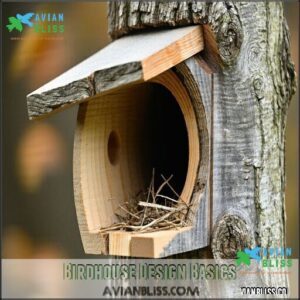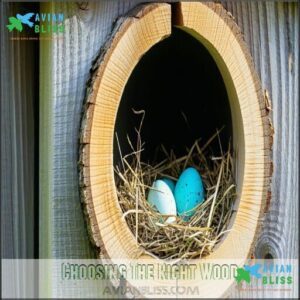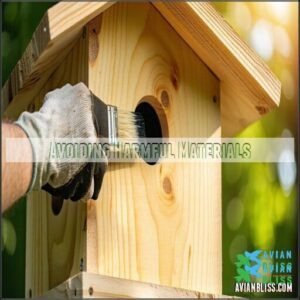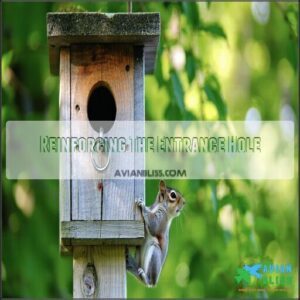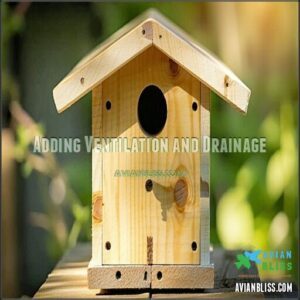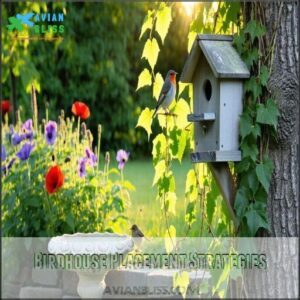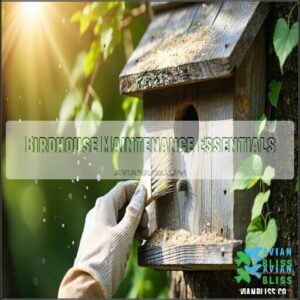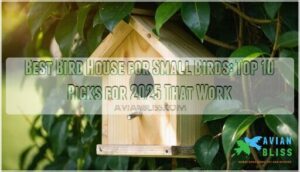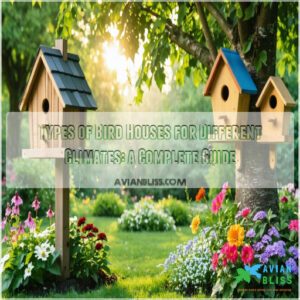This site is supported by our readers. We may earn a commission, at no cost to you, if you purchase through links.
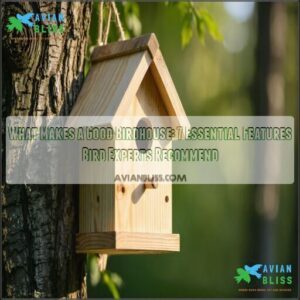
Think of it as building a tiny fortress that’s both comfortable and safe—birds need protection from elements and predators just like we need locks on our doors.
Natural, unpainted cedar or pine works best since birds aren’t impressed by fancy colors.
The difference between an occupied birdhouse and an empty one often lies in these seemingly small details.
Table Of Contents
Key Takeaways
- Use untreated wood like cedar or pine that’s at least ¾ inch thick for insulation and bird safety.
- Add proper ventilation and drainage holes to prevent overheating, moisture buildup, and disease.
- Ensure the birdhouse has a correctly-sized entrance hole to attract specific species and deter predators.
- Mount the birdhouse securely at the right height and direction, away from predators and feeders.
Birdhouse Design Basics
You’ll need to understand the scientific principles behind an effective birdhouse design before you can create a home that birds will actually use.
A well-designed birdhouse provides essential protection through proper insulation, ventilation, drainage, and weather-resistant materials that mimic the natural tree cavities birds seek in the wild.
A well-designed birdhouse mimics nature’s best shelters, offering protection through thoughtful engineering that birds instinctively recognize as home.
Insulation and Ventilation
The delicate balance between insulation and ventilation creates a bird-friendly microclimate in your birdhouse.
Wall thickness of at least 15mm provides essential thermal insulation against extreme temperatures. Place ventilation holes near the top where hot air naturally rises, ensuring proper air circulation without compromising warmth.
Material breathability matters too—cedar offers natural insulation while preventing condensation control issues.
For birdhouse optimization, consider ventilation and insulation.
In warmer regions, prioritize overheating prevention with additional ventilation; in colder areas, focus on heat retention.
Drainage and Water Runoff
Proper drainage safeguards your birdhouse from becoming a waterlogged disaster for its feathered residents.
Water accumulation can cause fatal hypothermia in nestlings and promote harmful mold growth.
To guarantee effectiveness, consider guaranteed hole placement.
- Include at least four ¼-inch drainage holes in the floor corners
- Angle the roof at 30° or steeper for ideal water runoff
- Extend roof overhangs 2+ inches to prevent rain splashback
- Consider material porosity when selecting wood for natural moisture control
The provided instructions are crucial for ensuring the birdhouse remains safe and healthy for its occupants, preventing issues like fatal hypothermia.
Material Selection
Beyond proper drainage, the right materials make your birdhouse a safe haven.
Choose untreated wood with natural decay resistance—cedar, redwood, and cypress top the list.
These woods offer excellent insulation properties and durability without harmful chemical treatments.
Pine works too but needs weather protection.
Always use wood at least ¾-inch thick, and avoid pressure-treated varieties which can harm birds.
What Makes Good Birdhouse
A good birdhouse serves as more than just a decorative garden fixture—it’s a safe haven designed to meet the specific needs of your feathered visitors.
When designing your avian home, understanding Species Preferences, Size Considerations, and Predator Deterrents will substantially impact its success.
- Safety features – Proper ventilation and drainage prevent nestlings from overheating or drowning, while thick wooden walls provide essential insulation against weather extremes.
- Species-specific design – Each bird species has unique birdhouse size requirements, from tiny wrens needing 1-inch entrance holes to wood ducks requiring spacious 10×10×24-inch chambers.
- Durability factors – Weather-resistant materials like cedar or cypress guarantee your birdhouse withstands the elements, offering Longevity Factors that benefit both birds and your maintenance schedule.
You’ll find birds quickly take to well-designed homes that prioritize their comfort and protection over mere Aesthetic Appeal. Consider using safe, non-toxic materials for construction.
Birdhouse Construction Tips
You’ll need untreated wood like cedar or pine that’s at least 3/4 inch thick to properly insulate your feathered visitors from harsh weather.
Making smart construction choices, from using galvanized screws instead of nails to adding essential drainage and ventilation holes, will create a safe, long-lasting home that birds will actually want to use.
Choosing The Right Wood
Why does wood choice matter for your feathered friends?
Cedar and redwood offer superior wood durability and pest resistance, lasting 10-15 years with minimal maintenance.
Pine costs less but requires treatment and won’t last as long.
Always select untreated wood for bird safety.
Consider different wood options for ideal birdhouse construction.
Thick walls (at least 3/4") provide essential wood insulation, keeping nestlings comfortable in all weather conditions, which is crucial for their bird safety.
Avoiding Harmful Materials
Now that you’ve selected your wood, it’s time to avoid the no-fly zone of toxic materials.
Pressure-treated lumber contains chemicals that can poison birds and their eggs. Skip oil-based paints, conventional varnishes, and anything containing pentachlorophenol.
Instead, opt for untreated cedar or redwood, which naturally resist decay.
For finishes, choose natural wood preservatives like Rubio Monocoat or tung oil for chemical-free protection.
Reinforcing The Entrance Hole
Just as you wouldn’t use treated wood, reinforcing the entrance hole is equally important for bird safety.
The hole size impact is significant – proper entrance size protects specific bird species while enhancing material durability.
A metal plate reinforcement around the birdhouse entrance hole prevents squirrels and other predators from enlarging it to access eggs or nestlings, and consider adding a predator guard for extra protection in your birdhouse design, which is crucial for bird safety.
Adding Ventilation and Drainage
While reinforcing the entrance keeps predators out, proper ventilation and drainage will keep the inside of your birdhouse healthy and dry.
Birds need airflow and water management to thrive in their homes. Untreated cedar offers excellent moisture resistance for birdhouses.
- Drill four 5/8" ventilation holes near the top of side walls
- Cut 1/4" deep grooves under roof edges for water runoff
- Include at least four 3/8" drainage holes in the floor
- Recess the floor 1/4" from the bottom to prevent rot
- Create a 15-degree roof overhang extending 2" beyond the entrance to ensure proper ventilation.
Birdhouse Placement Strategies
You’ll need to position your birdhouse strategically to attract your feathered friends, considering factors like height, direction, and protection from predators.
The perfect placement can mean the difference between an empty box and a thriving bird family, with most species preferring houses mounted 5-10 feet high on posts or trees and facing away from prevailing winds, which is a critical factor in their decision to inhabit the birdhouse.
Mounting and Installation
The perfect mount for your birdhouse can make all the difference between a busy bird nursery and an empty box.
Strategic mounting transforms an empty wooden box into a thriving avian nursery—location matters as much as design.
Proper installation keeps feathered families safe from predators while providing easy access for maintenance. To guarantee a comfortable environment, remember to take into account the entrance hole direction.
| Mounting Option | Height Considerations | Predator Deterrents |
|---|---|---|
| Metal Pole | 5-10 feet ideal | Add conical baffle |
| Tree Trunk | 12-15 feet recommended | Use predator guard |
| Building Wall | 8-12 feet, away from traffic | Mount on smooth surface |
The key to a successful birdhouse is not just the mounting option but also considering the height and predator deterrents to ensure the birds are safe and the maintenance is easy, providing a busy bird nursery with a safe environment.
Facing Direction and Height
When choosing your birdhouse’s facing direction and height, consider both the species you’re attracting and local environmental factors.
For ideal direction, face entrances east or southeast to provide morning warmth while avoiding afternoon heat.
Most birdhouses should be mounted 5-10 feet high, though specific species have different preferences, such as Purple Martins who prefer heights of 10-15 feet, while Bluebirds thrive at 5-6 feet in open areas, which is an important consideration for their well-being and local environmental factors.
Distance From Predators and Feeders
When considering birdhouse placement, keeping a safe distance from both predators and feeders creates an ideal balance for nesting birds.
Position birdhouses at least 20 feet from feeders to reduce traffic and stress while maintaining predator guards and baffles on mounting poles.
- Raccoons can reach into holes larger than their paws, threatening nestlings
- Cats lurking near birdhouses can devastate entire nesting families
- Hawks sometimes stake out busy feeding areas, making nearby nests vulnerable
- Squirrels chewing entrance holes wider can allow predator access
- Snakes climbing unprotected poles can consume eggs and hatchlings
Birdhouse Maintenance Essentials
You’ll need to maintain your birdhouse regularly by cleaning out old nesting materials and checking for damage that could harm its feathered residents.
Proper maintenance, which includes seasonal inspections and weather-proofing, guarantees your wooden shelter remains a safe, healthy environment for birds to raise their young year after year.
Cleaning and Upkeep
Scrub your birdhouse regularly to guarantee it remains a healthy haven for feathered visitors.
Proper maintenance prevents disease transmission and parasite infestations.
| Cleaning Task | Frequency | Tools Needed | Benefits |
|---|---|---|---|
| Nest removal | After breeding season | Gloves, mask | Prevents parasite control |
| Interior scrubbing | Annual cleaning | Soap solution or 1:9 bleach solution | Eliminates harmful bacteria |
| Inspection | Twice yearly | Flashlight | Identifies damage requiring repairs |
| Entrance hole check | During maintenance | Sandpaper, wood filler | Deters predators |
The table outlines the necessary cleaning tasks to maintain a safe environment for the birds.
By following these steps, you can ensure your birdhouse remains a welcoming and safe space for your feathered friends.
Protecting From Elements
Weather can wreak havoc on even the best-built birdhouses.
To protect your feathered friends’ homes from the elements:
- Apply a clear, water-based exterior sealant to untreated cedar or pine, avoiding the entrance hole and interior
- Verify the roof overhang extends 2-4 inches beyond the entrance for maximum rain protection
- Check ventilation holes and drainage solutions seasonally to prevent moisture buildup and wood treatment failure
Ensuring Bird Safety and Accessibility
Beyond weatherproofing your birdhouse, you’ll need to focus on safety features that protect your feathered tenants.
Install predator deterrents like metal entrance guards that prevent enlargement of the hole. Avoid perches, which give predators easy access.
Guarantee proper ventilation and drainage to prevent disease. Position houses where fledglings have a clear flight path for their first journey, reducing injury prevention risks.
Optimal placement can also deter predators. Regular birdhouse cleanliness creates safe nesting spaces for future families, ensuring a clear flight path.
Frequently Asked Questions (FAQs)
How to prevent squirrels from taking over?
Install baffles or metal guards on posts below your birdhouse.
You’ll also want to use smaller entrance holes that squirrels can’t fit through, and position houses away from trees or jumping points.
When is the best time to clean birdhouses?
You’ll want to clean birdhouses in late winter before nesting season begins or after each brood has fledged. Don’t wait too long, as early spring nesters will need clean homes.
Can birdhouses accommodate multiple bird families?
Yes, birdhouses can house multiple bird families if designed right.
Use larger "apartment-style" birdhouses with separate compartments.
Make certain proper ventilation, insulation, and drainage to keep everyone comfortable, and place it in a predator-safe spot.
How to deter invasive bird species?
To deter invasive bird species, reduce attractants like open food sources, avoid perches on birdhouses, and verify hole sizes match desired species.
Regularly monitor nests, remove invasive eggs, and install predator guards to maintain balance, ensuring the ecosystem remains healthy by taking these proactive measures, including removing invasive eggs.
Should birdhouses be removed during winter?
Leaving birdhouses up during winter provides roosting shelter for birds battling cold nights.
Clean them out after breeding season to remove old nests, preventing pests and disease, and ensuring a fresh start for spring nesting, which is crucial for the birds’ well-being and can be considered a key aspect of birdhouse maintenance.
Conclusion
Over 80 species of birds rely on artificial nesting sites, proving how essential a good birdhouse can be.
By focusing on proper dimensions, untreated wood, and features like drainage and ventilation, you’re creating a safe, comfortable home for your feathered friends.
Avoid perches that attract predators, mount securely, and place at the correct height for the species you want to attract.
With the right care and attention, your birdhouse can become a busy haven for local wildlife.

